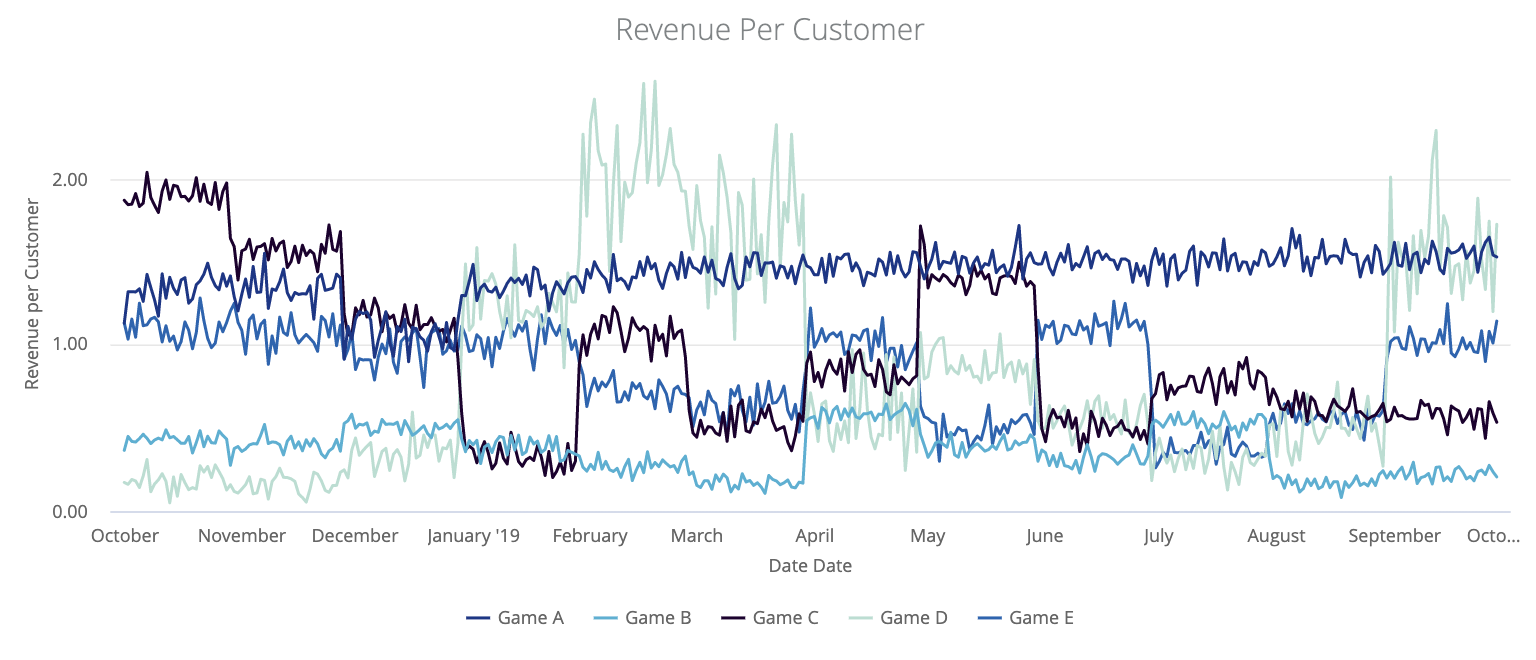What is Game Lifetime Value and How Do You Measure It?

Author: Eliott Perl
Building a new video game? Also featured in our on-demand webinar “Grow Your Game’s Lifetime Value”, we’ve summarized the key takeaways below on how data and analytics can help: derive Game Lifetime Value, make the right business decisions and define the right investment strategy.
The Rise of Gaming Analytics
Playing has always been part of our very nature. And ever since the invention of Pong in 1958 or the first commercial games in 1972 on Atari, video games have been an important part of our society and a central hub for innovation, creativity and passion.
But with games such as Minecraft, which has sold over 200 million copies across all platforms (with 126 million monthly active users as of 2020), or game franchises such as Call of Duty which have totalled over $17 billion since 2003 (roughly $1 billion per year!), it has become increasingly important to measure every aspect of game performances in order to ensure the right investment. From user behaviour and game telemetry to revenue and ROAS (Return on Advertising Spent), game analytics is a pivotal instrument to measure a game’s success and to make decisions on how to develop the future of a game.
One of the most basic and most valued KPIs when it comes to measuring the health of a game is the game Lifetime Value (LTV). But what exactly is a game LTV and how does this metric help game developers and publishers make business decisions?
Definition of Lifetime Value
At its most intrinsic definition, a game’s Lifetime Value measures the relationship between a player and a game and provides us with a sense of revenue obtained per customer for a given game.
Each unique game will have a set of indicators which will, in turn, help us define the level of player engagement and how long these players stay active during its “lifetime”.
It may be more or less complex to derive the LTV value depending on a multitude of factors like the type and genre of the game, the console or the platform it was released on, whether the game is free-to-play or paid, and by type of user (e.g. demographics and behaviour).
In essence, LTV is extremely useful to help marketers, product managers, developers and decision makers answer questions such as:
- How much will a game make from a player who spends a typical amount of time within that game?
- Is a game worth more investment?
- How do we monetise free-to-play games?
- Was a particular ad campaign successful and is it worth more investment?
- How should we develop our next successful game?
- What in-game feature should we develop?
At the end of the day, if a game’s LTV is higher than the cost of Player Acquisition (PA) or the Cost-Per-Install (CPI), the game will grow profitably which is the ultimate indicator of success.
How to Derive a Game’s Lifetime Value
As mentioned, this calculation will be based on potentially many factors and will need to be modelled around the specificities of your individual game, as different games have different methods to derive their LTV. But it’s essentially a metric that will fluctuate over time and its model will need to be updated daily. Some basic models like the well-established ‘retention/ARPDAU’ standards are usually a good place to start.

Building historical revenue curves (see below) and combining those values with player retention metrics also provides us with a clear sense of a game’s value, as well as to allow us to forecast and analyse financial data.
The K-factor, which measures how many ‘free organic installs’ a given game gets for every pound spent on UA, is also a great indicator of the game’s health. If you have a good game, the metric will be above one (if it is 1.2, then you will get 20 additional players for ‘free’ for every 100 players you buy).
There’s also a debate around the concept of “lifetime” of a game. A game’s lifetime is not a universal concept with a globally accepted definition. And it depends on the type of game: some games like free-to-plays can have a lifetime from one week to two months, but some mid-core games (games with a deeper sense of progression, with high accessibility across platforms and which require small or long sessions) and hardcore games (that require players to invest a lot of time to learn and has better overall player engagement) might take 12 months or more.
How Analytics Help With Defining and Monitoring Lifetime Value
To understand LTV, data really is everything. With a consistent and efficient data pipeline to ingest your data, you can derive an incredible amount of insights that help you make the right business decisions.
Metrics such as total players, players acquisition, session time, game time, concurrency, multiplayer activity, total revenue and revenue trends, ratio of paying customers or social media activity can all be combined into a single view to derive business-critical information and build a robust LTV model.

Depending on your platform and type of game, your in-game telemetry data also offers insightful value. It will help you understand things like your players’ behaviours or to identify features or components within your game where you will decide to place your next investment.

Do you want to find out more? Check out our free webinar on Growing Game Lifetime Value with our Partners at Looker.
At Datatonic, we’re a team of experts in the field of analytics, machine learning and artificial intelligence. We have a wealth of experience in gaming analytics and modelling, so get in touch for a free consultation and we will help you understand your users in detail, make the right business decisions and ultimately grow your games profitably.


